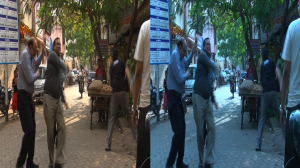Archive for October, 2010
 Our 3D Brains Can Be Very Forgiving!
Our 3D Brains Can Be Very Forgiving!
In my 3D camera workshops I discuss in detail the requirement that both left and right cameras match geometrically and photographically as closely as possible. And this is true. Yet over and over again I see examples of two wildly out of color balance L-R images that nevertheless display satisfactorily. This example from a recent class exercise on the streets of Mumbai illustrates my point. One eye (left) is balanced for daylight at 5600º K., the other (right) is preset for interior tungsten at 3200º K. Not surprisingly when viewed separately we see the obvious disparity in the two images, yet when overlaid and viewed in 3D the blue cast in the right eye seems to magically disappear. The brain processing the conflicting images opts intuitively for the correct one!
 Narrow Depth of Field for 3D?
Narrow Depth of Field for 3D?
It stands to reason: one looks at the world and we expect to see objects in focus. Blurry backgrounds and soft focus may be all the craze with the DSLR crowd, but remember such narrowly focused scenes lack clear depth cues and will quickly disorient your viewers. With the advent of 3D, shooters must again embrace cameras and camcorders with smallish sensors; the 2/3-inch imager size appears to be ideal with optimal depth of field and dynamic range. And there’s one other thing: The new Panasonic 3DA1 which I’ve been discussing at length throughout Asia features a relatively modest 1/4-inch chip array (one 3 X MOS chipset for each eye). The camera is notable because the small sensor while offering exceptional depth of field also features remarkable low light performance. How can that be that a tiny 1/4-in sensor can offer such superb low light response even at a lofty +24dB gain?
The overlaying of the left and right images produces a noise cancellation effect. Our brains effectively cannot see or process the noise under such circumstances and therefore disregards it. The result is very little visible noise even at extremely low light levels.
 3D in Asia Coming On Strong!
3D in Asia Coming On Strong!
I’ve been on the road nearly constantly of late, traveling through Australia and Southeast Asia including Malaysia, Vietnam and India. The response to my 3D camera workshops has been overwhelming with shooters and producers emerging from seemingly out of nowhere to grasp the 3D gold ring. This response while intense across Asia has been somewhat more tepid across North America and Europe and I wonder why. This may be simply attributable to the poor economy in the US and elsewhere, but I think it may be something more. The Asian market seems much more willing in general to embrace new technologies. The cinema in general here, especially in India is also much stronger, offering a ready and eager vehicle for 3D Bollywood grandeur and glitz.
Beyond feature film production I’m also seeing a surge of interest in 3D from travel and tourism concerns, museums, and even wedding and event producers who seem eager to offer 3D programming. This is in Asia. This trend while taking root now is nowhere so apparent in the USA and Europe, where the current DSLR fad and the allure of a narrow depth of field still appears strong.
